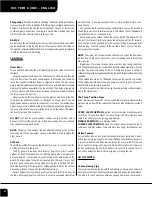
producTion of inflaTable boaT
4/
32
owner’s manual
specificaTions, descripTion and feaTures
5/
32
General
2. General
2.1 safeTy alerTs
This manual uses the following safety alerts to draw your attention to special
safety instructions that should be followed.
DANGER
- Denotes that an extreme intrinsic hazard exists which
would result in high probability of death or irreparable injury if proper
precautions are not taken.
WARNING
- Denotes that a hazard exist which can result in injury or
death if proper precautionsare not taken.
CAUTION
- Denotes a reminder of safety practices or direct atten-
tion to unsafe practices which could result in personal injury or dam-
age to the craft or component or to the environment.
2.2 naTional leGislaTion
Before you prepare for the water with your BUSH inflatable, check the local
legislation on any restrictions on the specific water you want to use. You
might check for speed-restriction and restrictions on the use of outboard
engines, restrictions on the airborne sounds, etc.
2.3 General safeTy informaTion
Safe Boating Suggestions.
In order to safely enjoy the waterways, familiarize yourself with local and
other governmental boating regulations and restrictions, and consider the
following suggestions:
WARNING:
If this boat is used around the mother ship at open sea,
take the necessary precautions! Don’t lose contact with the mother
ship!
ALWAYS WEAR A LIFEJACKET!
Use flotation devices. Have an approved personal flotation device of suitable
size for each person aboard (it is the law) and have it readily accessible.
Do not overload your boat. Most boats are rated and certified for maximum
load (weight) capacities (refer to your boat capacity plate). If in doubt, con
-
tact your dealer or the boats manufacturer.
Perform safety checks and required maintenance. Follow a regular schedule
and ensure that all repairs are properly made. Know and obey all nautical
rules and laws of the waterways.
Make sure everyone in the boat is properly seated. Do not allow anyone to
sit or ride on any part of the boat that was not intended for such use.
This includes the back of seats, gunwales, transom, bow, decks, raised fish
-
ing seats, any rotating fishing seat; or anywhere that an unexpected accel
-
eration, sudden stopping, unexpected loss of boat control, or sudden boat
movement could cause a person to be thrown overboard or into the boat.
Never be under the influence of alcohol or drugs while boating (it is the law).
Alcohol or drug use impairs your judgment and greatly reduces your ability
to react quickly. Prepare other boat operators. Instruct at least one other per-
son on board in the basics of starting and operating the outboard, and boat
handling, in case the driver becomes disabled or falls overboard.
Passenger boarding. Stop the engine whenever passengers are boarding,
unloading, or are near the back (stern) of the boat. Just shifting the outboard
into neutral is not sufficient.
Be alert. The operator of the boat is responsible by law to maintain a proper
lookout by sight and hearing. The operator must have an unobstructed view
particularly the front. No passengers load, or fishing seats should block the
operators view when operating the boat above idle speed.
Never drive your boat directly behind a water skier in case the skier falls. .
Watch fallen skiers. When using your boat for water skiing or similar activi-
ties, always keep fallen or down skier on the operator’s side of the boat while
returning to assist the skier. The operator should always have the down skier
sight and never back up to the skier or anyone in the water.

































